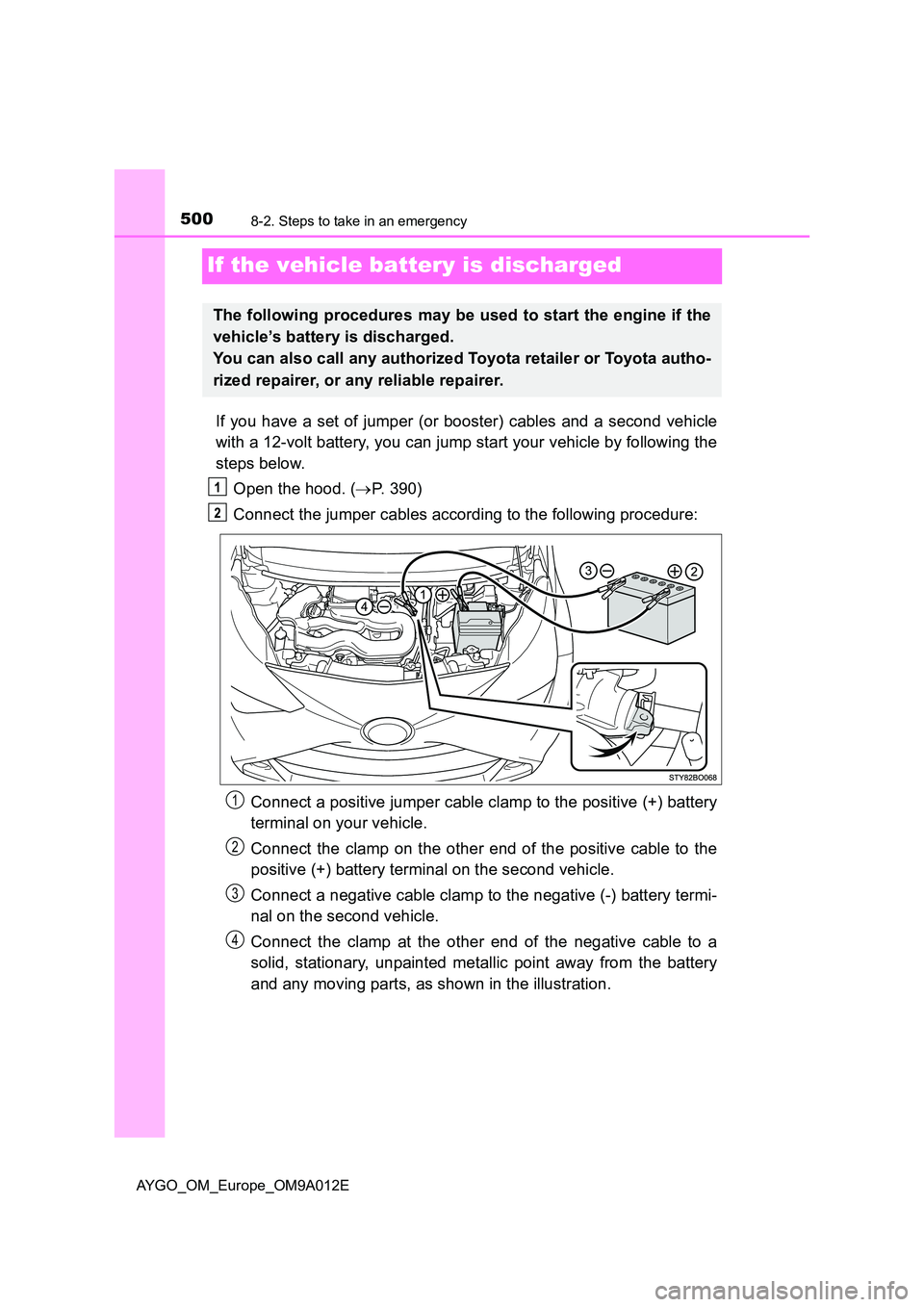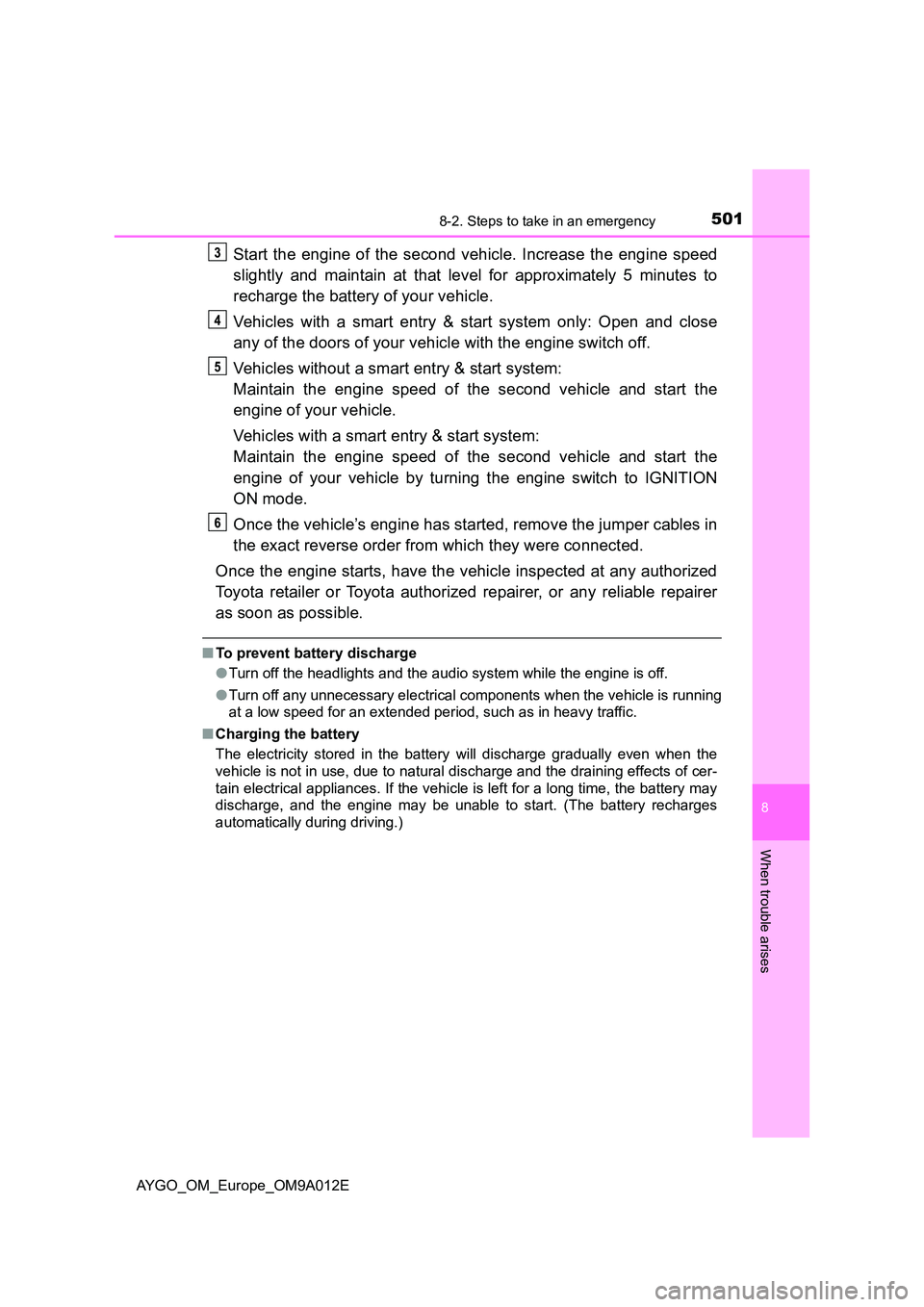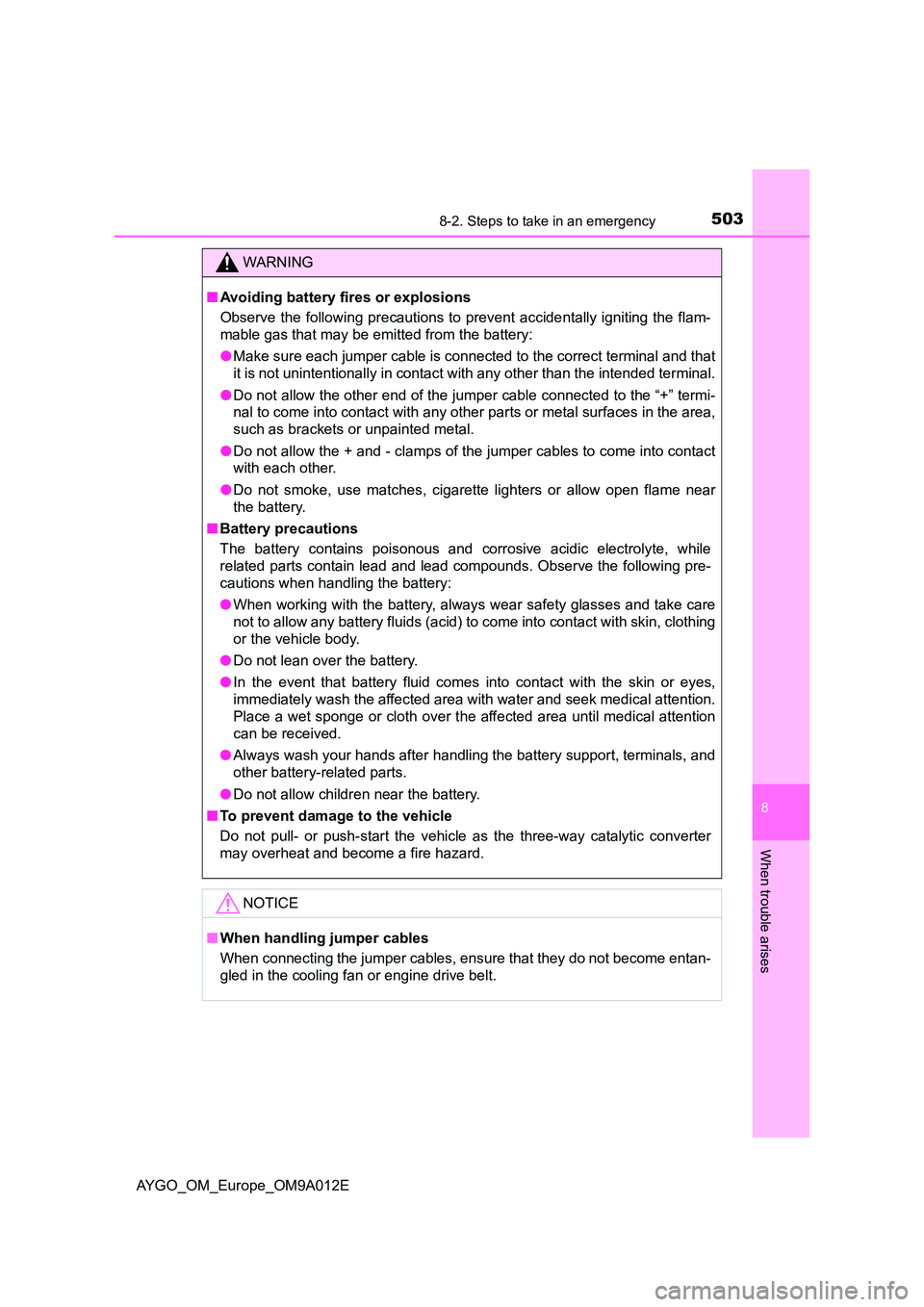Page 501 of 546
4998-2. Steps to take in an emergency
8
When trouble arises
AYGO_OM_Europe_OM9A012E
■Stopping the engine
Shift the shift lever to N and press the engine switch as you normally do when
stopping the engine.
■ Replacing the key battery
As the above procedure is a temporary measure, it is recommended that the
electronic key battery be replaced immediately when the battery is depleted.
( P. 415)
■ Changing engine switch modes
Release the brake pedal (multi-mode m anual transmission) or clutch pedal
(manual transmission) and press t he engine switch in step above.
The engine does not start and modes will be changed each time the switch is
pressed. ( P. 219)
■ When the electronic key does not work properly
● Make sure that the smart entry & start system has not been deactivated in
the customization setting. If it is off, turn the function on.
(Customizable features: P. 523)
● Check if battery-saving mode is set. If it is set, cancel the function.
( P. 146)
Page 502 of 546

5008-2. Steps to take in an emergency
AYGO_OM_Europe_OM9A012E
If the vehicle battery is discharged
If you have a set of jumper (or booster) cables and a second vehicle
with a 12-volt battery, you can jump start your vehicle by following the
steps below.
Open the hood. ( P. 390)
Connect the jumper cables according to the following procedure:
Connect a positive jumper cable clamp to the positive (+) battery
terminal on your vehicle.
Connect the clamp on the other end of the positive cable to the
positive (+) battery terminal on the second vehicle.
Connect a negative cable clamp to the negative (-) battery termi-
nal on the second vehicle.
Connect the clamp at the other end of the negative cable to a
solid, stationary, unpainted metallic point away from the battery
and any moving parts, as shown in the illustration.
The following procedures may be used to start the engine if the
vehicle’s battery is discharged.
You can also call any authorized Toyota retailer or Toyota autho-
rized repairer, or any reliable repairer.
1
2
3
4
Page 503 of 546

5018-2. Steps to take in an emergency
8
When trouble arises
AYGO_OM_Europe_OM9A012E
Start the engine of the second vehicle. Increase the engine speed
slightly and maintain at that level for approximately 5 minutes to
recharge the battery of your vehicle.
Vehicles with a smart entry & start system only: Open and close
any of the doors of your vehicle with the engine switch off.
Vehicles without a smart entry & start system:
Maintain the engine speed of the second vehicle and start the
engine of your vehicle.
Vehicles with a smart entry & start system:
Maintain the engine speed of the second vehicle and start the
engine of your vehicle by turning the engine switch to IGNITION
ON mode.
Once the vehicle’s engine has started, remove the jumper cables in
the exact reverse order from which they were connected.
Once the engine starts, have the vehicle inspected at any authorized
Toyota retailer or Toyota authorized repairer, or any reliable repairer
as soon as possible.
■ To prevent battery discharge
● Turn off the headlights and the audio system while the engine is off.
● Turn off any unnecessary electrical components when the vehicle is running
at a low speed for an extended period, such as in heavy traffic.
■ Charging the battery
The electricity stored in the battery will discharge gradually even when the
vehicle is not in use, due to natural discharge and the draining effects of cer-
tain electrical appliances. If the vehicle is left for a long time, the battery may
discharge, and the engine may be unable to start. (The battery recharges
automatically during driving.)
Page 504 of 546

5028-2. Steps to take in an emergency
AYGO_OM_Europe_OM9A012E
■ Precautions when the battery is discharged (vehicles with a smart entry
& start system)
● In some cases, it may not be possible to unlock the doors using the smart
entry & start system when the battery is discharged. Use the wireless
remote control or the mechanical key to lock or unlock the doors.
● The engine may not start on the first attempt after the battery has recharged
but will start normally after the second attempt. This is not a malfunction.
● The engine switch mode is memorized by the vehicle. When the battery is
reconnected, the system will return to the mode it was in before the battery
was discharged. Before disconnecting the battery, turn the engine switch off.
If you are unsure what mode the engine switch was in before the battery dis-
charged, be especially careful when reconnecting the battery.
■ When replacing the battery
● Use a battery that conforms to European regulations.
● Use a battery with the same case size as the previous one;
vehicles without cold area specifications or a stop & start system: (LN0),
20 hours rate capacity (20HR) is equiva lent (35Ah) or greater, and perfor-
mance rating (CCA) is equivalent (300A) or greater;
vehicles with cold area specifications: (LN0), 20 hours rate capacity (20HR)
is equivalent (42Ah) or greater, and performance rating (CCA) is equivalent
(390A) or greater; or
vehicles with a stop & start system: (LN2), 20 hours rate capacity (20HR) is
equivalent (60Ah) or greater, and performance rating (CCA) is equivalent
(540A) or greater.
• If the sizes differ, the battery cannot be properly secured.
• If the 20 hour rate capacity is low, even if the time period where the vehi-
cle is not used is a short time, the battery may discharge and the engine
may not be able to start.
● For details, consult any authorized Toyota retailer or Toyota authorized
repairer, or any reliable repairer.
Page 505 of 546

5038-2. Steps to take in an emergency
8
When trouble arises
AYGO_OM_Europe_OM9A012E
WARNING
■Avoiding battery fires or explosions
Observe the following precautions to prevent accidentally igniting the flam-
mable gas that may be emitted from the battery:
● Make sure each jumper cable is connected to the correct terminal and that
it is not unintentionally in contact with any other than the intended terminal.
● Do not allow the other end of the jumper cable connected to the “+” termi-
nal to come into contact with any other parts or metal surfaces in the area,
such as brackets or unpainted metal.
● Do not allow the + and - clamps of the jumper cables to come into contact
with each other.
● Do not smoke, use matches, cigarette lighters or allow open flame near
the battery.
■ Battery precautions
The battery contains poisonous and corrosive acidic electrolyte, while
related parts contain lead and lead compounds. Observe the following pre-
cautions when handling the battery:
● When working with the battery, always wear safety glasses and take care
not to allow any battery fluids (acid) to come into contact with skin, clothing
or the vehicle body.
● Do not lean over the battery.
● In the event that battery fluid comes into contact with the skin or eyes,
immediately wash the affected area with water and seek medical attention.
Place a wet sponge or cloth over the affected area until medical attention
can be received.
● Always wash your hands after handling the battery support, terminals, and
other battery-related parts.
● Do not allow children near the battery.
■ To prevent damage to the vehicle
Do not pull- or push-start the vehicle as the three-way catalytic converter
may overheat and become a fire hazard.
NOTICE
■ When handling jumper cables
When connecting the jumper cables, ensure that they do not become entan-
gled in the cooling fan or engine drive belt.
Page 518 of 546
5169-1. Specifications
AYGO_OM_Europe_OM9A012E
Ignition system
Spark plug
MakeDENSO FC16HR-Q8
Gap0.8 mm (0.031 in.)
NOTICE
■Iridium-tipped spark plugs
Use only iridium-tipped spark plugs. Do not adjust the spark plug gap.
Electrical system
Battery
Open voltage* at
20 C (68F):
12.3 V or higher
If the specific voltage is lower than the stan-
dard value, charge the battery.
(*: Voltage checked 20 minutes after the
engine and all the lights are turned off)
Charging rates5 A max.
Page 526 of 546
5249-3. Items to initialize
AYGO_OM_Europe_OM9A012E
Items to initialize
*: If equipped
The following item must be initialized for normal system opera-
tion after such cases as the battery being reconnected, or main-
tenance being performed on the vehicle:
ItemWhen to initializeReference
Tire pressure warning
system
*When changing the tire sizeP. 406
Page 528 of 546

526What to do if... (Troubleshooting)
AYGO_OM_Europe_OM9A012E
What to do if... (Troubleshooting)
●If you lose your keys or mechanical keys, new genuine keys or mechanical
keys can be made by any authorized Toyota retailer or Toyota authorized
repairer, or any reliable repairer. (P. 1 1 4 )
●Vehicles with a smart entry & start system
If you lose your electronic keys, the risk of vehicle theft increases signifi-
cantly. Contact any authorized Toyota retailer or Toyota authorized
repairer, or any reliable repairer immediately. (P. 131)
●Is the key battery weak or depleted? (P. 415)
●Vehicles with a smart entry & start system
Is the engine switch in IGNITION ON mode?
When locking the doors, turn the engine switch off. (P. 219)
●Vehicles with a smart entry & start system
Is the electronic key left inside the vehicle?
When locking the doors, make sure that you have the electronic key on
your person.
●The function may not operate properly due to the condition of the radio
wave. (P. 136, 146)
●Is the child-protector lock set?
The rear door cannot be opened from inside the vehicle when the lock is
set. Open the rear door from outside and then unlock the child-protector
lock. (P. 135)
If you have a problem, check the following before contacting any
authorized Toyota retailer or Toyota authorized repairer, or any
reliable repairer.
The doors cannot be locked, unlocked, opened or closed
You lose your keys
The doors cannot be locked or unlocked
The rear door cannot be opened (5-door models)